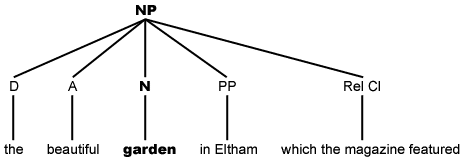Noun phrases
A noun phrase (NP) can consist of one word (for example, the pronoun we or the plural noun cats), or it can consist of a noun with a number of dependents. The dependents occur before or after the noun head depending on their function. For example, the new boat that I bought yesterday is a noun phrase containing the determiner the, the adjective new, the head noun boat, and the relative clause that I bought yesterday.
Noun phrases often function as complements to the verb; for example, in the clause Many people run the marathon every year, the NPs many people and the marathon function as the subject and object respectively. The NP every year is an adjunct, which is an optional element in the grammatical structure of this clause.
Contents1. NP heads 4. Agreement of subject NPs and verbs Related pages |
NP heads
All noun phrases (NPs) have a noun or pronoun as the head. The noun is the anchor of the phrase and the phrase will not be grammatical without it. For example, the NP a really lovely dress from my favourite shop is ungrammatical if the word dress is omitted: * a really lovely from my favourite shop.
Pronouns can stand in place of an NP. An easy way to see how pronouns can substitute for larger constituents is to try substitution. We can substitute it for the NP that house on Plenty Road in the clause I have to paint that house on Plenty Road so that we have I have to paint it.
NP dependents
The NP can also have different types of dependents, such as determiners (for example, those, the), adjectives (for example, beautiful, green), nominal modifiers (nouns which modify other nouns, for example, bluestone house), prepositional phrases (for example, in Eltham) and relative clauses (for example, which the magazine featured). The dependents modify the noun by adding information. The structure of the noun phrase the beautiful garden in Eltham which the magazine featured is given below:

A dependent in the NP can also be categorised according to its position in the NP:
Determiners, nominal modifiers and adjectives occur before the NP head. (Determiners can have modifiers as well, for example, at least twelve eggs.)
There is often restriction on the order of other pre-head constituents. For example, determiners always occur before adjectives: the long red satin ribbon, not *satin the red long ribbon.
Some adjectives (often with their own complements) can occur as post-head modifiers, for example, someone skilled, or people taller than 180cm.
Post-head modifiers in an NP include prepositional phrases (for example, boats on the water), modifying NPs (for example, my sister Bertha, or children her age), relative clauses (for example, a friend [who/whom] I've known for fourteen years) and non-finite clauses (for example, swans floating on the lake).
Function of NPs
Noun phrases often function as complements to the verb. This means that they fulfil specific grammatical functions required by the verb. The examples below show NPs functioning as subjects and objects in different clauses.
subject NPs typically appear before the verb, and control the verb's inflectional agreement (for example, Fenella sings well).
object NPs typically follow the verb and are affected by the situation described by the verb (for example, Atticus taught Felix).
We can see that a large NP such as in the diagram above behaves as a unit (constituent) in clause structure because we can use it as a subject or object in a sentence in a similar way to a NP with only one element, the head noun or pronoun:
[The beautiful garden in Eltham which the magazine featured]SUBJECT is closed on Mondays.
[Parliament]SUBJECT is closed on Mondays.
[It]SUBJECT is closed on Mondays.
We all loved [the beautiful garden in Eltham which the magazine featured]OBJECT.
We all loved [dinner]OBJECT.
We all loved [it]OBJECT.
Other functions in the clause that an NP can fulfil include the role of complements and adjuncts.
There are a number of types of constituents that take NP complements. At clause level, an NP can function as a subject complement (for example, Georgia is an architect) or an object complement (for example, We voted Kerry class representative). NPs also funciton as complements in prepositional phrases (for example, under the bed).
Noun phrases can also function as adjuncts within a clause. Adjuncts are not essential to a clause but provide additional information (for example, We meet for lunch most Fridays).
Agreement of subject NPs and verbs
Because NPs can be quite complex, it is sometimes difficult to identify the NP head and choose the correct verb inflection to mark subject-verb agreement. Some examples are given below:
The wearing of jeans and shorts is/are not permitted in this restaurant.
The problem here is that there are three nouns; wearing, jeans and shorts. Plural shorts is closest to the verb, but the head of this NP [The wearing of jeans and shorts] is the noun wearing, which is singular. We can test that this is the subject NP by substituting the NP with pronoun it. Since the head of the NP is singular, the correct verb form is is. However, many speakers of English are just as comfortable with the plural reflecting the number of shorts or jeans and shorts.
Twenty dollars is/are a good price.
Here the sum of money is seen as a single unit, so the verb is singular is. Likewise, the quantifier dozen in the sentence; A dozen rolls is enough.
The board is/are deciding as we speak.
Nouns referring to a group of individuals are usually considered to be singular, but this can vary according to the context and the speaker's focus, for example, The team is here and The team are all prepared.

